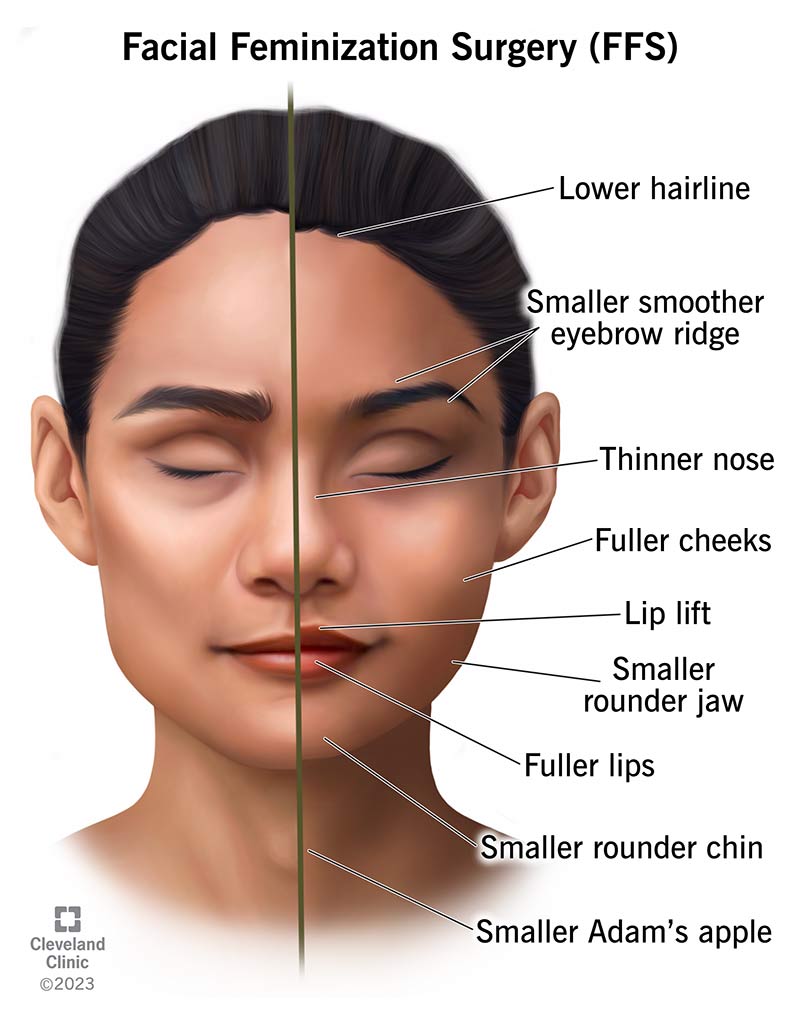Facial feminization surgery (FFS) involves one or more procedures to make the features of your face more traditionally feminine. FFS can include a wide range of procedures, including jaw reduction, nose reshaping and cheek augmentation.
Advertisement
Cleveland Clinic is a non-profit academic medical center. Advertising on our site helps support our mission. We do not endorse non-Cleveland Clinic products or services. Policy

Facial feminization surgery (FFS) changes features on your face to look more traditionally feminine. It might involve one surgery or a series of procedures.
Advertisement
Cleveland Clinic is a non-profit academic medical center. Advertising on our site helps support our mission. We do not endorse non-Cleveland Clinic products or services. Policy
FFS uses bone, cartilage and soft tissue reshaping to soften your facial features. People commonly seek FFS to enhance their nose, jaw, forehead and hairline.
Anyone can have feminizing facial surgery. As long as you’re healthy enough to have surgery, you can have FFS.
You may not be a good candidate for FFS if you:
A plastic surgeon specializing in surgery of your face, head and neck performs facial feminization surgery. This type of healthcare provider specializes in surgery to change or enhance your physical appearance.
Before facial feminization surgery, your healthcare provider will perform a thorough personal assessment. They’ll ask you about your goals for surgery and explain what you can expect during your recovery after the procedure. It’s important that you and your surgeon have goals that are aligned and realistic.
Your provider also makes sure you’re in good physical health by:
Advertisement
You might also have imaging scans before facial feminization surgery. X-rays or CT (computed tomography) scans take pictures of the bones and soft tissues of your face and skull. Your surgeon may also measure your face, take photographs and assess your skin quality. All of this information helps your surgeon plan your treatment.
Facial feminization surgery is different for everyone. The process depends on the facial features you choose to change. You might have one surgery or several, including:
It depends on your situation and whether you’re having one or multiple procedures. If you have everything done during one surgery, it can take up to eight or nine hours. Some surgeons recommend splitting the procedures into two surgeries, separated by seven to 10 days or longer. Doing two surgeries gives your face more time to heal.
You’ll have gauze or bandages over your incisions for several days. You might wear compression wraps around your forehead or jaw to reduce inflammation.
You may go home with a surgical drain. A drain is a thin, plastic tube that your surgeon places under your skin. It helps drain blood and fluid to reduce swelling.
Feminizing facial surgery can help you feel more confident and secure. It can boost your self-esteem and improve your quality of life.
Risks of facial feminization surgery include:
Your healthcare provider will probably take out the nonabsorbable stitches a week after your surgery, or they may place absorbable stitches that don’t require removal. Once your stitches are gone, it’ll still take several weeks to fully heal and achieve your desired results.
Advertisement
Recovery varies from person to person and depends on several factors, including what procedures you choose, your health history and your body’s healing capacity. While most healing occurs over the first two to six weeks (like reduced bruising and swelling), your body will continue to recover over the coming months. For most people, it takes about one year to see full results.
Any time you have a surgical procedure, you can expect some degree of discomfort, swelling and bruising. But you shouldn’t have severe pain — and any discomfort should improve with medication.
Most people who have feminizing facial surgery report minimal pain. Your surgeon will give you a list of postoperative instructions and provide you with any necessary prescriptions.
Yes, your FFS results should last the rest of your life. Injectable treatments (like dermal fillers) are the only exception. If you choose to plump up certain features with dermal fillers, you’ll need retreatment at some point. Some fillers last a few months while others can last up to five years.
Contact your healthcare provider right away if you experience any of these complications after your surgery:
Advertisement
The decision to get facial feminization surgery is very personal. When your appearance doesn’t fully reflect the way you feel inside, it can take a toll. Feminizing facial surgery helps soften your features to look more traditionally feminine. Everyone has their own perception of femininity, so this can mean different things for different people. To get the results you want, find a healthcare provider who understands your cosmetic goals and makes you feel confident in their ability to achieve them.
Advertisement
If you have conditions affecting your ears, nose and throat, you want experts you can trust. Cleveland Clinic’s otolaryngology specialists can help.

Last reviewed on 08/01/2023.
Learn more about the Health Library and our editorial process.